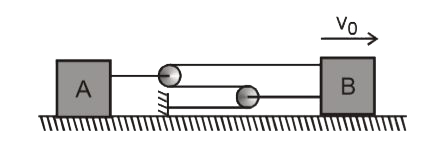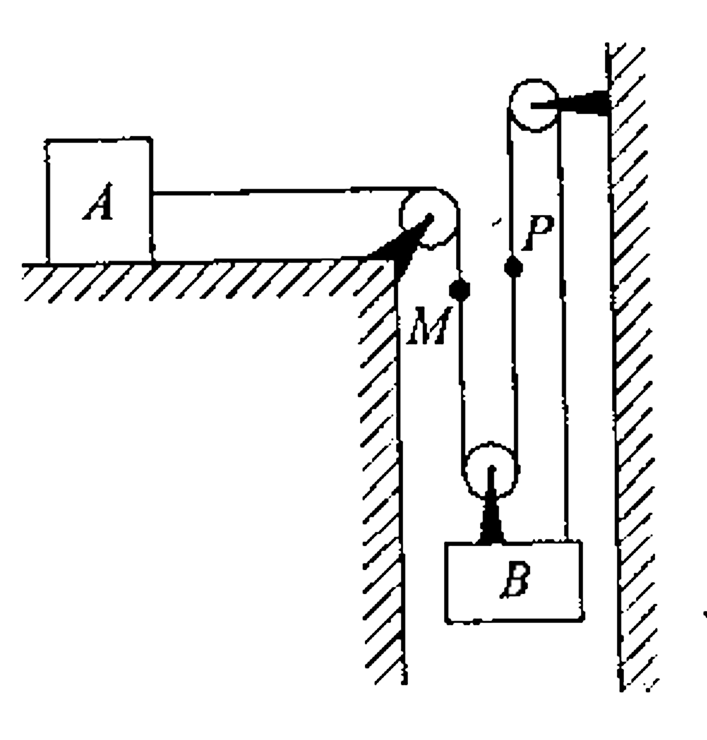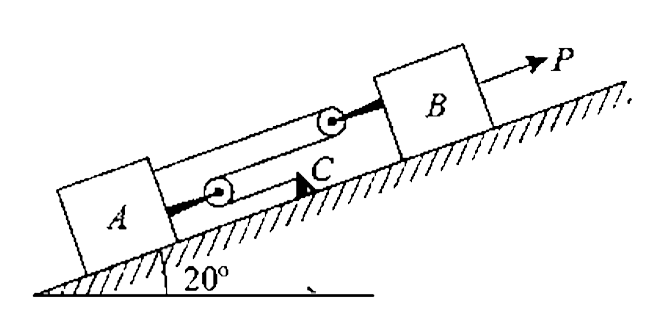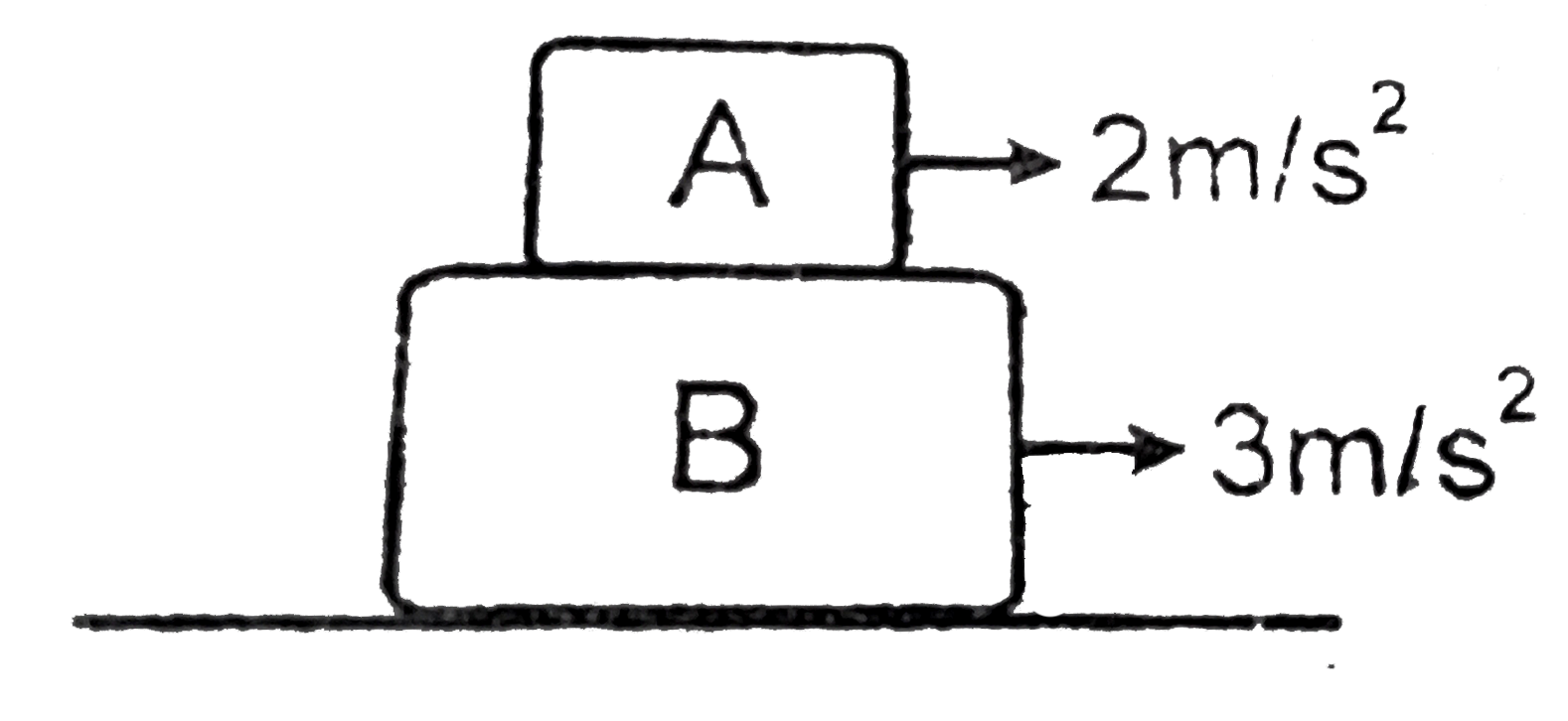Under to action of force P the constant acceleration of block B is 3ms−2 to the right At the instant when the velcoity of B is 2ms−1 to the right determine the absolute velocity of point C of the cable
 .
.
2
1
3
4
The correct Answer is:B
−3TVB+4TVA=0,VA=34VB=32
VB+VC2=VA,VC=2VA−VB,VC=3−2=1 .
Topper's Solved these Questions
- BOOK - NARAYNACHAPTER - NEWTONS LAWS OF MOTIONEXERCISE - SINGLE ANSWER QUESTIONS Passage -11videos
NEWTONS LAWS OF MOTION
- BOOK - NARAYNACHAPTER - NEWTONS LAWS OF MOTIONEXERCISE - INTEGER TYPE QUESTIONS23videos
NEWTONS LAWS OF MOTION
- BOOK - NARAYNACHAPTER - NEWTONS LAWS OF MOTIONEXERCISE - NCERT BASED QUESTION33videos
NEWTONS LAWS OF MOTION
- BOOK - NARAYNACHAPTER - MOTION IN A STRAIGHT LINEEXERCISE - Level 2 H.W29videos
MOTION IN A STRAIGHT LINE
- BOOK - NARAYNACHAPTER - OSCILLATIONSEXERCISE - EXERCISE - IV41videos
OSCILLATIONS
Similar Questions
Block B moves to the right with a constant velocity v0. The velocity of body A relative to B is :
 View Solution
View SolutionTwo blocks A and B are shown in figure. Block A moves to the left with a constant velocity of 6m/s. Find :

(a) Velocity of the blocks B.
(b) Velocity of the point P of the string.
Relative velocity of the point M of the cable with respect to the point P.View Solution
Knowledge Check
- Question 1 - Select One
Under the action of force P, the constant acceleration of block B is 3ms−2 to the right. At the instant when the velocity of B is 2ms−1 to the right, determine the velocity of B relative to A, the acceleration of B relative to A and the absolute velocity of point C of the cable.
 A2B1C3D4
A2B1C3D4 - Question 2 - Select One
Under the action of force P, the constant acceleration of block B is 6m/sec2 up the incline. For the instant when the velocity of B is 3m/sec up the incline. Choose the correct option(s)
 AVelocity of B relative to A is 1 m/sBAcceleration of B relative to A is 2m/s2CThe velocity of point C of the cable (in ground frame) is 4 m/sDVelocity of B relative to A is 2 m/s
AVelocity of B relative to A is 1 m/sBAcceleration of B relative to A is 2m/s2CThe velocity of point C of the cable (in ground frame) is 4 m/sDVelocity of B relative to A is 2 m/s - Question 3 - Select One
A block A has a velocity of 0.6ms−1 the right. Determine the velocity of cylinder B.
 A1.2ms−1B2.4ms−1C1.8ms−1D3.6ms−1
A1.2ms−1B2.4ms−1C1.8ms−1D3.6ms−1
Block B shown in figure , moves downwards with a constant velocity of 20cm/s. At t = 0, block A is moving upward with a constant acceleration, and its velocity is 3cm/s. If at t=3s blocks C has moved 27 cm to the right, determine the velocity of block C at t = 0 and the acceleration of A and C.
 View Solution
View SolutionBlock B moves to the right with a constant velocity v0. The velocity of body A relative to B is
 View Solution
View SolutionBlock A is kept on block B as shown in figure. It is known that acceleration of block A is 2m/s2 towards right and acceleration of block B is 3m/s2 towards right under the effect of unknown forces. Direction of friction force acting on A by B (μAB=0.3)
 View Solution
View SolutionFor the pulley system shown in fig. each of the cables at A and B is given a velocity of 2ms−1 in the direction of the arrow. Determine the upward velocity v of the load m.
 View Solution
View SolutionUnder the action of a given coulombic force the acceleration of an electron is 3.5×1025ms−2. Then the magnitude of the acceleration of a proton under the action of same force is nearly
View Solution

